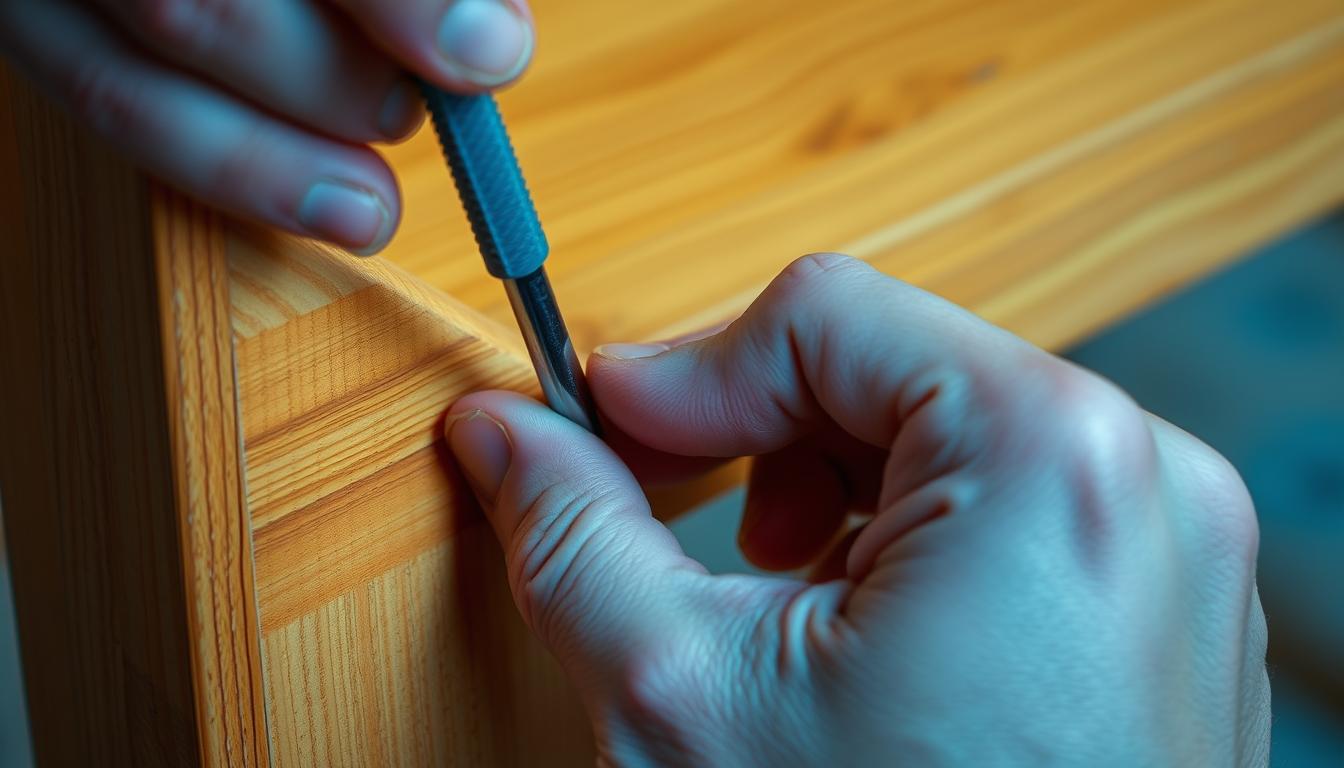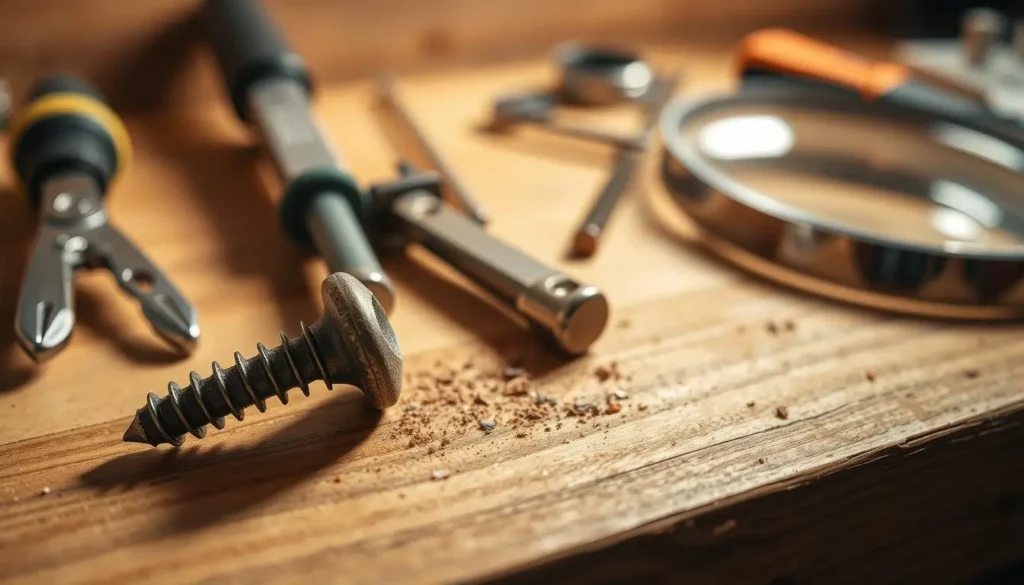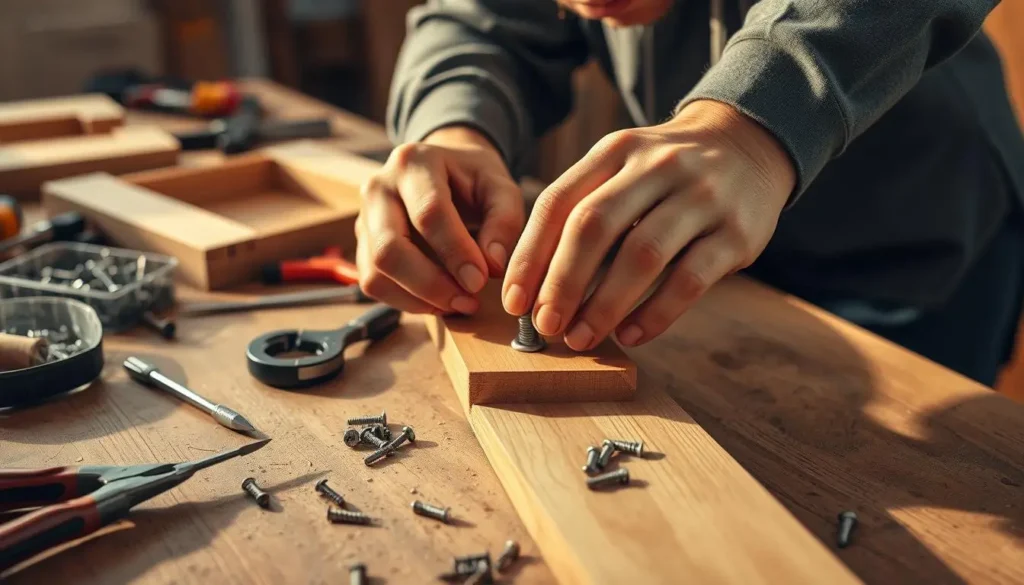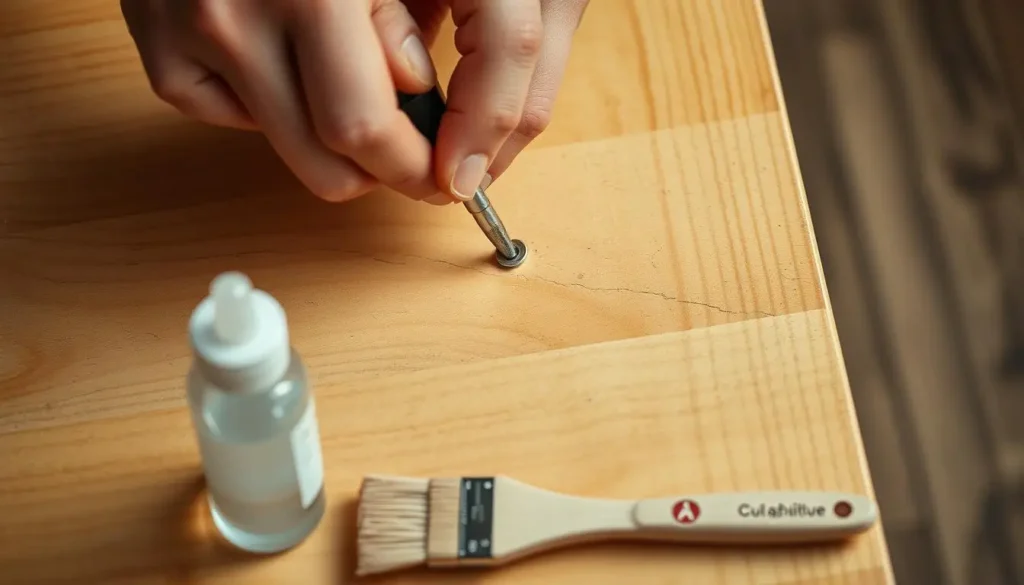How to Fix Loose Screws in Wood: Easy DIY Guide 2025
Have you ever seen a loose screw in your wooden chair or table? It makes things unstable and can be dangerous. If you’re wondering how to fix loose screws in wood, you’re not alone—loose screws can be a real nuisance, harming your wooden furniture.
Maintaining your wooden furniture is very important. Fixing loose screws is a big part of this. It keeps your furniture safe, looking good, and lasting longer.

Learning how to fix loose screws in wood is a big step. It helps you take care of your furniture better. This skill can also save you money and make your furniture last longer.
Understanding Why Screws Become Loose in Wood
When screws get loose in wood, it means there’s a problem. Understanding the reasons behind this is the first step in learning how to fix loose screws in wood effectively.
Common Causes of Screw Loosening
There are a few reasons screws get loose. Wood shrinking and expanding, and screws getting worn out, are the main ones.
Wood Shrinkage and Expansion
Wood changes size with humidity and temperature. This can make screws loose. It’s important to think about this when fixing screws.
Repeated Use and Stress
Using screws a lot can make them loose. This happens in things that carry weight or get used a lot. The screw gets worn out and pulls out of the wood.
Identifying the Severity of the Problem
Before fixing screws, check how bad the problem is. Look at the screw and test if it’s stable.
Visual Inspection Techniques
Look for signs of wear or damage around the screw. Cracks, splits, or color changes show how bad it is. Being careful is important for fixing it right.
Testing Screw Stability
Try gently pulling on the screw or twisting it a bit. If it’s easy to move, it needs fixing. This test shows how serious the problem is.
| Cause | Description | Impact |
|---|---|---|
| Wood Shrinkage/Expansion | Changes in wood size due to humidity/temperature | Screws become loose as wood around the screw hole changes size |
| Repeated Use/Stress | Constant strain on screws due to weight or frequent use | Screws pull out of the wood, creating loose connections |

“The key to fixing loose screws is understanding why they become loose in the first place. By addressing the root cause, you can ensure a more permanent solution.”
Expert Carpenter
Essential Tools and Materials for Fixing Loose Screws
Fixing loose screws needs the right tools and materials. The right equipment makes the job easier and fixes it better.
Basic Tools You’ll Need
You’ll need basic tools to fix loose screws. These include screwdrivers, drills, and tools for measuring and marking.
Screwdrivers and Drill Options
You’ll need screwdrivers, like flathead and Phillips-head. Also, a drill with different bits is useful. Choosing the right tool for your screw is important to avoid damage.
Measuring and Marking Tools
Measuring and marking accurately is key for good repairs. Use a ruler or tape measure and a pencil to mark your work area. Being precise helps avoid mistakes.
Materials for Different Repair Methods
For different repairs, you might need different materials. These include wood repair supplies, adhesives, and fillers.
Wood Repair Supplies
For big repairs, you might need dowels or wood filler. These help rebuild the area around the screw.

Adhesives and Fillers
Adhesives like wood glue or epoxy can make the screw hole stronger. Fillers can fix damaged areas for a smooth surface. Choosing the right adhesive or filler is key for a lasting fix.
Quick and Simple Solutions for Mildly Loose Screws
There are easy ways to fix mildly loose screws at home. If you’re searching for how to fix loose screws in wood with simple DIY methods, these solutions are perfect for you.
The Toothpick Method
The toothpick method is simple and works well. It uses toothpicks to fill the gap left by a loose screw.
Step-by-Step Application
First, take out the screw. Then, dip a few toothpicks in wood glue. Put them in the hole and wait for them to dry.
After they dry, cut off the extra toothpick. Then, put the screw back in.
Tips for Better Results
Use more toothpicks if the hole is big. This method is best for small to medium holes.
Using Wooden Matchsticks
Wooden matchsticks can also fix loose screws. It’s like the toothpick method but uses matchsticks and wood glue.
Preparation and Installation
Take out the screw and dip matchsticks in wood glue. Put them in the hole. Wait for the glue to dry.
Then, cut off the extra matchstick. Put the screw back in.
When This Method Works Best
This method is good for bigger holes. Matchsticks make the fit tighter.
Paper or Card Stock Technique
The paper or card stock method uses small pieces to fill the gap. It’s easy to do.
Materials and Application
Remove the screw and fill the hole with paper or card stock. You can use wood glue to hold it. Put the screw back in when it’s full.
Limitations of This Method
This method is quick but not as strong. It’s best for small repairs.
| Method | Materials Needed | Durability |
|---|---|---|
| Toothpick Method | Toothpicks, Wood Glue | High |
| Using Wooden Matchsticks | Wooden Matchsticks, Wood Glue | High |
| Paper or Card Stock Technique | Paper or Card Stock, Optional: Wood Glue | Low to Medium |

How to Fix Loose Screws in Wood Using Adhesives
Fixing loose screws in wood is easy with adhesives. They fill gaps and make the screw hold better. We’ll look at the best adhesives and how to use them.
Wood Glue Application Technique
Wood glue is great for fixing screws. It’s important to apply it right for the best fix.
Preparing the Screw Hole
Make sure the screw hole is clean before using glue. Use a brush or air to get rid of dust. This helps the glue stick well.
Applying Glue and Reinserting the Screw
Put a little glue in the hole. Then, put the screw back in and wait for it to dry. This makes the screw hold tighter.
Using Epoxy for Severely Damaged Holes
Epoxy is better for big damage. It makes a strong bond and fills big gaps.
Mixing and Applying Epoxy
Follow the instructions to mix the epoxy. Put it in the damaged area to fill it up.
Curing Time and Finishing
Wait for the epoxy to dry as directed. After it’s dry, sand it smooth and put the screw back in.
When to Use Super Glue
Super Glue is good for quick fixes. It works well for small repairs.
Quick Repairs with Cyanoacrylate
Put a little Super Glue in the hole and let it dry. This fixes small looseness fast.
Combining Super Glue with Other Methods
For more strength, mix Super Glue with other fixes. Like using toothpicks or matchsticks.

Choosing the right adhesive and using it right fixes loose screws. Wood glue, epoxy, and Super Glue all have their uses.
Advanced Methods for Severely Stripped Screw Holes
When you have severely stripped screw holes in wooden furniture, you need advanced repair methods. These methods fix your furniture and make it last longer.
Wooden Dowel Technique
The wooden dowel technique is great for fixing severely stripped screw holes. You fill the hole with a wooden dowel and then drill a new hole for the screw.
Selecting and Sizing Dowels
Choose a dowel that’s a bit bigger than the hole. Choosing the right size is very important for a good fit.
Installation and Finishing
Put wood glue on the dowel and push it into the hole. After it dries, cut off the extra dowel and drill a new hole. This makes a solid spot for the screw.
Using Wood Filler for Repairs
Wood filler is also good for fixing stripped screw holes. It fills the hole so you can screw into it again.
Types of Wood Fillers
There are many wood fillers out there, like epoxy-based and water-based ones. Epoxy-based fillers are very strong and last a long time.
Application and Drying Process
Follow the maker’s instructions to apply the filler. Let it dry completely. Then, sand it smooth.
Installing Wood Screw Inserts
Wood screw inserts are a strong fix for damaged screw holes. They give a new thread for the screw, making it secure.
When to Use Threaded Inserts
Use threaded inserts when the hole is very damaged and other fixes won’t work.
Installation Process
Drill the hole to fit the insert, then screw in the insert. This makes a strong and lasting fix.
| Repair Method | Best For | Durability |
|---|---|---|
| Wooden Dowel Technique | Severely stripped holes | High |
| Using Wood Filler | Moderately damaged holes | Medium |
| Installing Wood Screw Inserts | Severely damaged holes | Very High |
Preventive Measures to Avoid Loose Screws in Wooden Furniture
Learning how to stop screws from coming loose can save you a lot of time. When you work with wood, it’s important to avoid loose screws. You can do this by using the right methods and materials.
Proper Drilling Techniques
Drilling correctly is key to avoiding loose screws. You need to pick the right hole size and drill at the right speed and pressure.
Pilot Hole Sizing Guide
The pilot hole size is very important. It should be a bit smaller than the screw. If it’s too big, the screw will be loose. If it’s too small, the wood might split.
Drill Speed and Pressure
Drilling too fast or with too much pressure can damage the wood. This can make screws come loose.
Choosing the Right Screws for Wood
Picking the right screws is another way to prevent loose screws. You need to know about different screws and their uses. Also, you should know the right sizes.
Screw Types and Their Applications
There are screws for different jobs. For example, coarse-thread screws are good for softwoods. Fine-thread screws are better for hardwoods.
Understanding Wood Screw Sizes
Screw sizes vary, and picking the right one is important. The screw’s length and thickness should match the wood and project.
By taking these steps, you can make your wooden furniture last longer. You’ll spend less time fixing loose screws.
Conclusion
Fixing loose screws in wood is very important. It keeps your wooden furniture strong and lasts longer. We talked about many ways to fix loose screws, from simple tricks to more complex methods.
Knowing why screws get loose helps you fix them right. You can stop more damage and keep your furniture solid. No matter how loose the screws are, there’s a way to fix them.
Keeping your furniture in good shape is easy. Use the right tools and screws for wood. This way, you won’t have to deal with loose screws often.
We’ll answer more questions about fixing loose screws soon. This will help you understand how to fix them quickly and why it’s so important.
Key Takeaways
- Loose screws can make your wooden furniture unstable and unsafe.
- Fixing loose screws is key to keeping your furniture in good shape.
- Knowing how to fix loose screws can save you money and make your furniture last longer.
- It’s a simple skill that makes your furniture safer and look better.
- Regular care can stop loose screws from becoming a bigger problem.
FAQ
What are the common causes of loose screws in wood?
Loose screws in wood can happen for a few reasons. Wood can shrink or expand, causing screws to come loose. Using screws a lot can also make them loose. Plus, drilling wrong can damage the wood and screws.
How do I identify if a screw is loose in wood?
To check if a screw is loose, look at the screw hole. If the screw feels loose or wobbly, the hole might be damaged.
What is the toothpick method for fixing loose screws, and how does it work?
The toothpick method uses toothpicks to fill the gap in the screw hole. This makes the screw fit better. It’s a simple way to fix slightly loose screws.
Can I use adhesives to fix loose screws in wood, and what types are recommended?
Yes, you can use adhesives like wood glue, epoxy, or super glue. The right one depends on how bad the damage is. Choose based on what you need to fix.
How can I prevent loose screws in wooden furniture?
To stop screws from coming loose, drill right and use the right screws. Also, check your furniture often. This helps catch problems early.
What are some advanced methods for repairing severely stripped screw holes?
For really bad screw holes, you can use dowels, fillers, or screw inserts. These methods can fix the hole for good.
How do I tighten loose screws in wooden furniture without causing further damage?
To tighten screws, try toothpicks, adhesives, or advanced fixes. Pick the best method for your damage. This helps avoid making things worse.
Are there any DIY screw tightening techniques I can try at home?
Yes, you can try using toothpicks, matchsticks, or paper. These are good for slightly loose screws. They’re easy to do at home.
Here are some other guides to read
How to Store Onions to Last Longer: Chef-Approved Secrets That Work
Why Are English Speaking Countries So Rich? It’s Not What You Think
